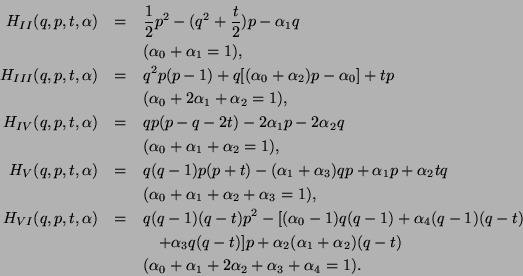![]() The purpose of this paper is to show that we can take coordinate
systems determined by the Bäcklund transformations as coordinate systems
of the manifolds of Painlevé systems constructed by K. Okamoto ([10])
(except the first one) and that the manifolds with parameters equivalent
under the corresponding affine Weyl groups are mutually isomorphic.
The purpose of this paper is to show that we can take coordinate
systems determined by the Bäcklund transformations as coordinate systems
of the manifolds of Painlevé systems constructed by K. Okamoto ([10])
(except the first one) and that the manifolds with parameters equivalent
under the corresponding affine Weyl groups are mutually isomorphic.
The ![]() -th Painlevé system (
-th Painlevé system (
![]() ) which is equivalent
to the
) which is equivalent
to the ![]() -th Painlevé equation is the following
Hamiltonian system
-th Painlevé equation is the following
Hamiltonian system

Each Painlevé system determines a complex one dimensional nonsingular
foliation of
![]() where
where
On the other hand, each Painlevé system admits a Bäcklund
transformation group of certain birational symplectic transformations
each of which preserves the form of the Hamiltonian and changes
the parameters ![]() as an element of an affine Weyl
group ([6], [7], [8], [9]).
This fact was first recognized by K. Okamoto
([11]), but our presentation in the following is different from his.
as an element of an affine Weyl
group ([6], [7], [8], [9]).
This fact was first recognized by K. Okamoto
([11]), but our presentation in the following is different from his.
Let
![]() (
(
![]() ) be a differential field of rational
functions of
) be a differential field of rational
functions of
![]() with a derivation
with a derivation ![]() defined by
defined by
(i) each
(ii)
![]() , for
, for ![]() ,
,
(iii)
![]() for
for
![]() .
.
The group
For
We extend the domain of definition
![]() of
(
of
(![]() ) by all
) by all ![]() . Let
. Let
![]() be
a manifold obtained by gluing the copies
be
a manifold obtained by gluing the copies
![]() of
of
![]() via the relations
via the relations

The manifold
![]() is a fiber space over
is a fiber space over ![]() and the
extension of the Painlevé system (
and the
extension of the Painlevé system (![]() ) on
) on
![]() defines a complex one dimensional nonsingular foliation of
defines a complex one dimensional nonsingular foliation of
![]() each leaf of which is transversal to fibers.
each leaf of which is transversal to fibers.
The main result of this paper is stated as:
Theorem 1.
The identity mapping ![]() from
from
![]() to
the original chart
to
the original chart
![]() of
of ![]() can be extended to an isomorphism
can be extended to an isomorphism
In the proof of the theorem, the uniformity of the foliation
Corollary. The manifolds ![]() and
and
![]() are isomorphic if there exists
are isomorphic if there exists ![]() such that
such that
![]() .
.
In a private communication, we were informed that H. Umemura and
J. Matsuzawa had also obtained the corollary.
We notice that the manifold
![]() is covered by a finite
number of coordinate systems although it is defined by infinitely many
ones. The fact is verified by the above corollary, the following
theorem in which
is covered by a finite
number of coordinate systems although it is defined by infinitely many
ones. The fact is verified by the above corollary, the following
theorem in which ![]() are the generators of
are the generators of ![]() , and the property that,
for any
, and the property that,
for any ![]() , there is a
, there is a ![]() such that none of
such that none of ![]() (and
(and
![]() for
for ![]() ) vanish.
The theorem is also used in the proof of Theorem 1.
) vanish.
The theorem is also used in the proof of Theorem 1.
Theorem 2. (The case of ![]() )
If none of
)
If none of ![]() vanish, then
vanish, then

(The case of ![]() )
If none of
)
If none of ![]() and
and
![]() vanish, then
vanish, then

In Section 2, we give lists of certain generators of Bäcklund
transformation groups of Painlevé systems and show some
propositions which will be used in the proof of Theorem 1.
In Section 3, we review the descriptions of the manifolds
![]() ([14],[4]) and give lists of Hamiltonians on all
charts and then we show a proposition.
The succeeding sections are devoted to proving
Theorems 1 and 2. We first prove Theorem 2 in Section 4 and then prove
Theorem 1 in Sections 5 and 6. In the case of
([14],[4]) and give lists of Hamiltonians on all
charts and then we show a proposition.
The succeeding sections are devoted to proving
Theorems 1 and 2. We first prove Theorem 2 in Section 4 and then prove
Theorem 1 in Sections 5 and 6. In the case of ![]() , there appear
divisors in
, there appear
divisors in
![]() and a divisor in
and a divisor in ![]() at infinity
of the original chart which are invariant with respect to the foliations,
and hence we have to observe them precisely.
at infinity
of the original chart which are invariant with respect to the foliations,
and hence we have to observe them precisely.
In the end of this section, we note a work by H. Watanabe in which he has given some relations between Bäcklund transformations and suitable descriptions of the manifolds ([16], [17]).